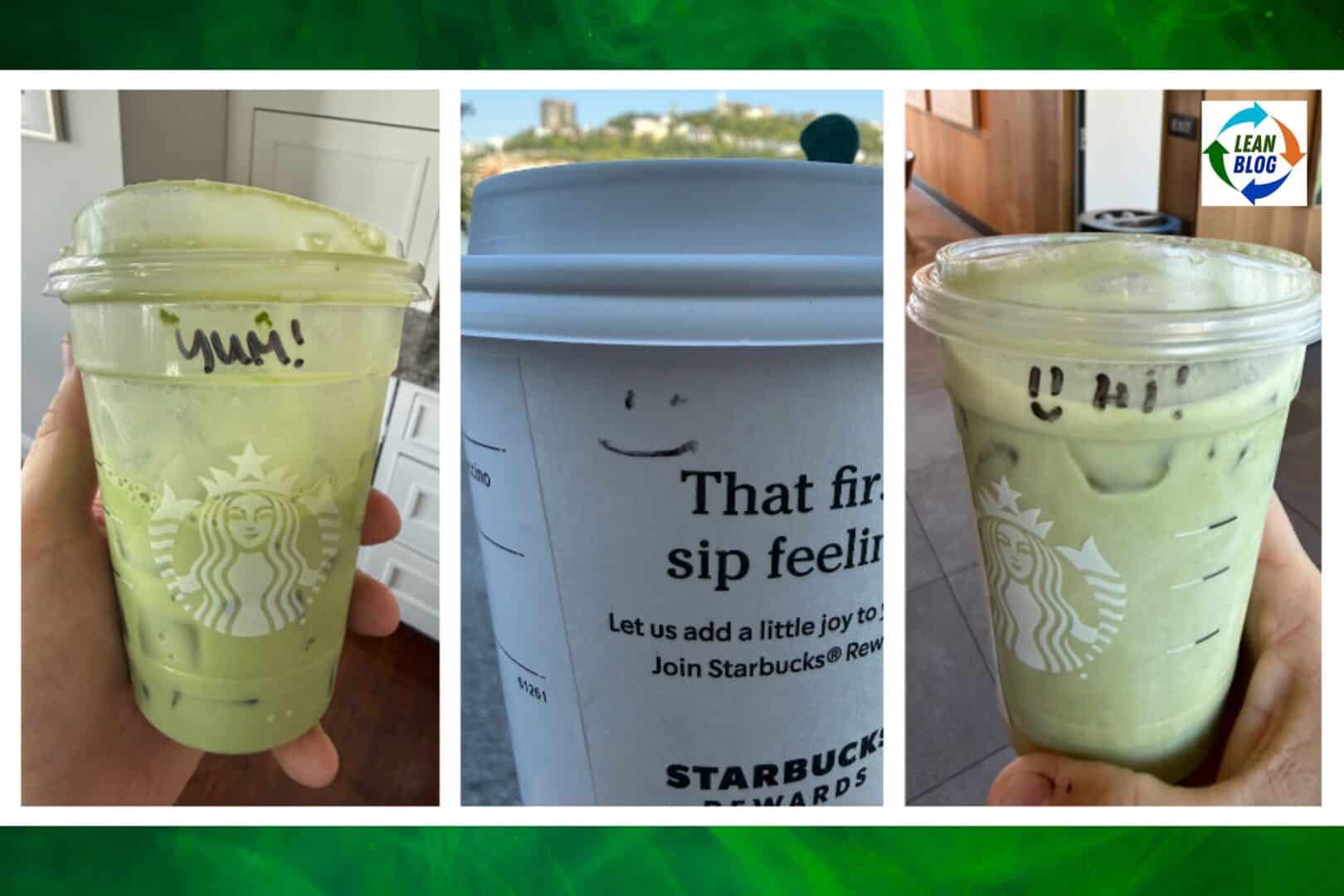Starbucks has been in the headlines for a renewed push toward hospitality and “moments of connection.” The Wall Street Journal recently reported on new training that scripts greetings, eye contact, and even handwritten cup messages–along with operational changes like better order sequencing and added staffing (“Has Your Starbucks Barista Been Acting Especially Friendly Lately? Here's Why,” WSJ, Sept. 19, 2025, by Heather Haddon). The link there is free for subscribers.
I remember one barista who wrote “You're awesome!” on my Nitro Cold Brew cup. They were making quite the assumption about me, eh? :-)
Jamie Flinchbaugh and I chatted about this topic in Season 2, Episode 5 of Lean Coffee Talk. We asked: what do Starbucks customers truly value–and how do Lean concepts help us separate what matters most from the nice-to-have gestures? Here's a clip:
Signals vs. Systems
Writing “Have a nice day!” or “Yum!” on a cup is a signal of caring. A consistently accurate, on-time drink in a calm, predictable café is a system of care.
That said, different customers value different things. Personally, I can do without a handwritten “Yum!” or “Have a nice day!” on my Nitro Cold Brew. What I do appreciate–when the baristas have the time–is a genuine smile, eye contact, and a quick hello. For me, that's more meaningful than Sharpie messages. But I also know plenty of customers who don't care about that either–they just want the drink fast, correct, and available.
This variation in customer preference makes it all the more important to design a system that delivers the fundamentals reliably, while leaving space for employees to add authentic touches when time and context allow.
When leadership overweights signals (smiles, scripts, Sharpies) without fixing the system, two risks emerge:
- Customer cynicism: It can feel performative if the experience around it is still chaotic.
- Employee frustration: Adding steps (and seconds) to already overloaded work increases stress and creates more opportunities for misses–hardly a recipe for great hospitality.

That's sort of a sad smiley face, ironically, on that middle cup. That was written on a cappucino that I ordered for my wife. The smiley face was on the side of the cup facing away from the side she would drink from. So would that even ben noticed?
Respect for People Means Removing Barriers
The WSJ piece describes corporate efforts to add labor, create greeter roles, standardize handoffs, and reduce crowding. Good. Those are in the right direction if they remove barriers to doing the work the right way, the first time.
From a Lean perspective, “respect for people” isn't about mandating friendliness–it's about designing jobs (ans a system) that allows baristas to succeed:
- Clear, visual specs (labels that capture the order flawlessly)
- Smooth, leveled flow between mobile, café, and drive-thru
- Realistic labor standards and staffing for peaks
- Easy access to tools and supplies right where they're needed
If you really want consistent smiles, design a system that reduces struggle. People smile more when the work works.
The Sharpie Question
In our Lean Coffee Talk episode, Jamie and I laughed about doing a time study on the Sharpie cap: do we really want to allocate precious seconds to uncap-write-recap when the label already tells the story of the order?
On Reddit, baristas themselves pointed out that Starbucks allocates three seconds of labor time for taking the cap off the Sharpie and putting it back on. Three seconds doesn't sound like much, but in Lean terms, those micro-burdens add up across hundreds of drinks a day. Worse, employees noted they can't “batch up” the writing of messages during slow times (to level the work) because of hygiene concerns about touching cups and putting them back into the stack. That means the Sharpie step has to happen in the middle of drink assembly, when the pressure is already highest.
For some customers, those handwritten notes might be delightful. Again, for me, not so much. And for others, even eye contact might feel unnecessary or uncomfortable. That's the point: customer value isn't one-size-fits-all. Starbucks would do well to let baristas flex and personalize within a system that ensures the basics–accuracy, speed, and availability–are always in place.
If messages on cups are truly valuable to customers, let's test it. Run a small PDSA:
- Hypothesis: Handwritten messages improve perceived hospitality and customer service scores without degrading speed or accuracy.
- Measures: Order accuracy, drink lead time, re-makes, customer feedback, and employee stress signals.
- Method: Try it during defined windows, with realistic staffing, and compare against a matched control period.
If it helps, keep it (and standardize the how). If it doesn't, remove the waste and reinvest those seconds in flow and quality.
My Real Customer Requirement: Don't Stock Out
Here's a practical, unglamorous voice of the customer: Please don't run out of Nitro Cold Brew.
Stockouts scream, “The system isn't under control.” This happens quite often, in my experience, Stockouts erode trust far faster than a missing smiley face. Preventing stockouts is plain old Lean supply-chain and store-level replenishment:
- Forecast using real demand patterns (and yes, use a Process Behavior Chart to separate signal from noise).
- Tighten the kanban loop between store and distribution.
- Error-proof the prep schedule so the tap doesn't go dry at 9:30 a.m.
A café that has what I want, when I want it, prepared correctly, in a reasonable time–that's value. If you also make it warm and welcoming, wonderful. But please start with availability, flow, and quality.
Go See, Listen Deeply, Improve Scientifically
Starbucks leaders are reportedly visiting stores and adding resources. Keep going:
- Go to the gemba. Watch the actual work. Where do orders bunch up? Where do baristas struggle?
- Ask employees. “What gets in the way of delivering a great drink on time?” Then remove those barriers.
- Measure what matters. Flow time, first-time-right, re-makes, stockouts, and employee strain–not just scripted behaviors.
- Improve with PDSA. Pilot changes, study effects, adjust. Don't roll out scripts faster than you fix the system.
Visiting executives don't need to be all-knowing heroes with all of the answers. Your baristas and store managers probably know what most of the problems are. And they likely have ideas for countermeasures that could be tested. So, listen to them. But be ready to support them when they raise systemic challenges that only executives can address.
The Bottom Line
Hospitality is an outcome of good systems and humane work design. If Starbucks uses training and scripting to highlight a desired experience while simultaneously fixing flow, clarifying specs, staffing properly, and preventing stockouts, customers will feel the difference–no Sharpie required.
And if you're reading this from Seattle or your local district office: I'll happily trade a heart on my cup for a reliably available Nitro Cold Brew that's ready in under four minutes. Every day. That's the kind of “moment of connection” I value.
Please scroll down (or click) to post a comment. Connect with me on LinkedIn.
Let’s build a culture of continuous improvement and psychological safety—together. If you're a leader aiming for lasting change (not just more projects), I help organizations:
- Engage people at all levels in sustainable improvement
- Shift from fear of mistakes to learning from them
- Apply Lean thinking in practical, people-centered ways
Interested in coaching or a keynote talk? Let’s talk.
Join me for a Lean Healthcare Accelerator Trip to Japan! Learn More









